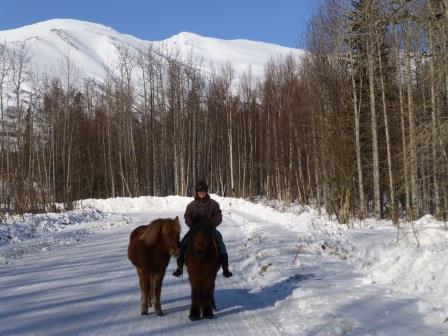
Home > Trip > Dispatches > Daily Dispatches 2013 > Daily Dispatch #56
February 25, 2013: Pony Grrrrl Deep In Thought
Today I rode Signy and ponied Raudi, then rode Raudi and ponied Signy. Then, when Pete got home from school, I rode Signy and ponied Raudi, and he rode Siggi and ponied Hrimmi. There are certain combinations that work better than others – Tinni and Signy would both prefer to be the pony horse. But I am varying the order because you never know when it might have to be this way. For example, the riding horse could twist an ankle out on the trail, in which case the order might have to be reversed. The good thing is, all combinations are working out well, so well in fact that quite often I don’t have to give the horse being ponied much thought. And ponying |
|
| horses is becoming routine, so much so that Pete today remarked that it would be fun to just “go for a ride.” Dunno, I’m having a really good time and I think so are the horses. Even Little Hrimmi is catching on. Signy is doing her job, which is upping my confidence level. She’s a very strong and very forward little gal. I call her my little fire engine. I have yet to see her tire. And her trot is ongoing. I’m glad we have her. Today, as I was riding, I was thinking about what’s going on in my work life. This morning I finished the Rasmuson Grant proposal, and this afternoon Pete (after giving it yet one more once over) got it in the mail. This was truly a joint effort –he worked on this as much as I did. It’s nice, our abilities complement one another. It would not be good for me to live with another creative writer – little would ever get done. The proposal – it’s done, done. I suppose I could have spent even more time on it, but I could say this about just about every piece of writing that I work on. At some point you have to let the kite go and watch the wind take it upward. I have, between proposal drafts, been working on my TTeam Practitioner questions. The explanatory paragraph that accompanied the document stressed that this is not an exam, but rather a way of furthering one’s knowledge of the subject area. So I’m mulling over each and every one of the 147 questions in an attempt to both learn more things and to expand upon what it is that I already know. I’m enjoying this as much as I’m enjoying teaching the horses to pony. The test is what I call sprawling. I get to answer 25 questions of my own choosing, and 50 or so required questions. Each could, in and of itself, be an essay. There was one really odd question – “What would you tell someone who asked you what you thought of their horse?” I really liked this one – I created a Socratic dialogue, which, through direct questioning, enabled the client to answer this question for them self. It went like this: Alys: What specifically about your horse are you interested in knowing more about? I don’t have to be working towards practitioner status because I have no aspirations to be a horse trainer. I have finally accepted my lot in life, which is to be a creative writer. (Becoming a veterinarian or taking on a job as a political activist are now also out.) However, the more I know about this particular methodology, the better off me and my herd of five will be. TTeam work is a very intuitive sort of animal training, which is why I like it. For example, the individual body work techniques each have an animal name, and behind each name is a story. For example, the term python lift came about after Linda Tellington Jones used specific, and now time-honored, methods on a python. This use of stories by someone like myself, who knows of their importance, resonated with me. TTeam work also requires that the practitioner see given situations from the animals’ point of view. Answering the questions is also forcing me to articulate what I’m doing, so that I can better explain things to others, particularly those who are skeptical about such practices. Because of its more intuitive nature, there are many out there who are skeptical about TTeam work. I don’t know where I am going, but I feel in part in answering these questions like I’m on my way. |
|
